Week 3
Online/in-Person Graduate course, University of California, Riverside, Department of Physics and Astronomy, 2019
The Foundation of Applied Machine Learning
Spring 2019
Instructor: Prof. Bahram Mobasher
Teaching Assistance: Abtin Shahidi email abtin.shahidi–at–email.ucr.edu
Course webpage: https://abtinshahidi.github.io/teaching/2019-spring-foundation-machine-learning
« Go to Week 2
Go to Week 4 »
Week 3
Continuing on Statistics and python:
In the following exercise we are going to make some assumption about data, make a model, and fit the parameters of the model:
Flip A Coin: Is this Coin Really Fair?
Imagine that you want to measure the fairness of a given coin:
You run the following experiment:
- You count number of heads per $N=20$ coin toss.
- You do the previous line 100 times.
And this is the outcome of the experiment:
data_array = [ 6, 7, 8, 11, 8, 7, 8, 9, 8, 5, 12, 7, 5, 8, 8, 8, 10,
9, 9, 7, 5, 11, 6, 2, 9, 8, 11, 8, 10, 5, 9, 11, 8, 9,
7, 8, 6, 8, 12, 9, 11, 9, 6, 7, 11, 5, 9, 6, 8, 12, 6,
8, 7, 8, 8, 11, 5, 6, 6, 7, 12, 9, 7, 8, 9, 7, 11, 7,
9, 4, 8, 9, 9, 9, 12, 6, 8, 7, 10, 6, 5, 8, 9, 7, 8,
7, 9, 7, 7, 12, 9, 11, 6, 5, 9, 7, 9, 7, 11, 8]
First we need to come up with a model for the data. We need to find the probability of each outcome first, before getting into the estimation for fairness. Let’s ask a simple questions: What are the possible outcomes of a coin toss?
The answer is: (Head, tail) or (0,1) or (True, False) or (win, lose)
So, if we assume that the probability of getting 1 is $p$ and $p$ is not going to change throughout the experiment. Also, by definition the probability of getting 0 is $q=1-p$. ($p$ is a quantity we are looking for, since it is a measure for the fairness of the coin)
Let’s say that we are going to toss the coins $N$ times and we get $n$ desired outcome. (e.g. Head is the desired outcome)
But, what are the chances of getting $n$ out of $N$ coin tosses?
$n$ desired outcome probability is $p^n$; also we have $N-n$ undesired outcome during the experiment which means that the total probability of getting $n$ 1s and $N-n$ 0s is $p^n q^{N-n}$
Also, we do not care about the order of the coin toss. (e.g. (1,0,0,0,1), (0,1,1,0,0), (1,1, 0, 0, 0) all are considered same outcome) So, we need to multiply the previous probability by number of configurations. (Number of ways you can choose $n$ ones, and $N-n$ zeros; which is: $\binom {N}{n}$
So the probability of the $n$ heads out of $N$ coin toss, when the probability of single head is $p$, is the following: \(\begin{equation} p(n\|N,p)=\binom {N}{n} p^n (1-p)^{N-n} \end{equation}\) Which is called the binomial distribution.
There is a pre-defined binomial function in scipy package. However, since we are still trying to get familiar with python, let’s write the function ourself as below:
# importing packages
import numpy as np
import matplotlib.pyplot as plt
# use LaTeX fonts in the plot
plt.rc('text', usetex=True)
plt.rc('font', family='serif')
def binomial(n=0, N=1, p=1):
"""
This is the probability mass function for the binomial distribution.
INPUT:
n: Number of desired outcome
N: Number of trials
p: Probability of a desired outcome for each separate coin toss
OUTPUT:
Probability of getting n desired outcome, out of N trials,
when the probability of desired outcome is p
"""
from math import factorial
factor = factorial(N)/(factorial(n)*factorial(N-n))
return factor*(p**n)*(1-p)**(N-n)
Now we need to make some assumption about prior distribution of $p$ which is the quantity of the interest.
Since we have no other information about the coin before-hand we can assume a Uniform prior for $p$. So, let’s sample from $10^5$ values for $p$ from this uniform distribution.
number_of_points = 10**5
prior_p = np.linspace(0,1, number_of_points)
Importing time() for getting a benchmark for different methods:
from time import time
A simple for loop:
In the following cell, we are going to calculate the probability of getting all the values in the data-set, while using different $p$. Since, we can assume that the experiments are independent, we can simply multiply all the probabilities. Then looking for the $p$ value which maximize that probability; or in other words, is the most likely value for $p$ given our data-set.
You should notice that we are using the Bayes’ law again; we are looking for $P(p|X)$ in which $X$ is the whole data-set. But, we can turn that around and look for much simpler quantity, using Bayes’ law: $P(p|X) \sim P(X|p)$
N = 20
prob_p_cat=np.zeros(number_of_points)
ti=time()
for i,p in enumerate(prior_p):
prob=1
for data in data_array:
prob *= binomial(data, N, p)
prob_p_cat[i] = prob
tf=time()-ti
print("For loop method for {} data points and {} simulations (sampling p) takes: {:10.3f} seconds ".format(len(data_array), number_of_points, tf))
For loop method for 100 data points and 100000 simulations (sampling p) takes: 24.183 seconds
This is the most likely value according to the description above.
prior_p[prob_p_cat==max(prob_p_cat)]
array([0.40300403])
Using numpy.vectorize:
In this method instead of using a for loop on the elements of the data set we can use the numpy.vectorize(binomial), which allows us to give the vectorized function the whole array of data.
vec_binomial = np.vectorize(binomial)
N = 20
prob_p_cat=np.zeros(number_of_points)
ti=time()
for i,p in enumerate(prior_p):
prob_p_cat[i] = np.prod(vec_binomial(data_array, N, p))
tf=time()-ti
print("numpy.vectorize method for {} data points and {} simulations (sampling p) takes: {:10.3f} seconds ".format(len(data_array), number_of_points, tf))
numpy.vectorize method for 100 data points and 100000 simulations (sampling p) takes: 19.482 seconds
prior_p[prob_p_cat==max(prob_p_cat)]
array([0.40300403])
You can see that the numpy.vectorize method is a little bit faster than the simple for loop.
fig_p = plt.figure(figsize=(8,8))
# Just normalizing the probability to maximum value so most likely
# value corresponds to 1.
# For getting the through probability we need to find the Integral
# of the un-normalized distribution.
plt.plot(prior_p, prob_p_cat/max(prob_p_cat), markersize=1)
plt.title(r"\textbf{Probability distribution of fairness measure($p$)}", fontsize=20)
plt.xlabel(r"Coin fairness: $p$", fontsize=18)
plt.ylabel(r"Aribitrary Normalized Probability", fontsize=18)
plt.show()
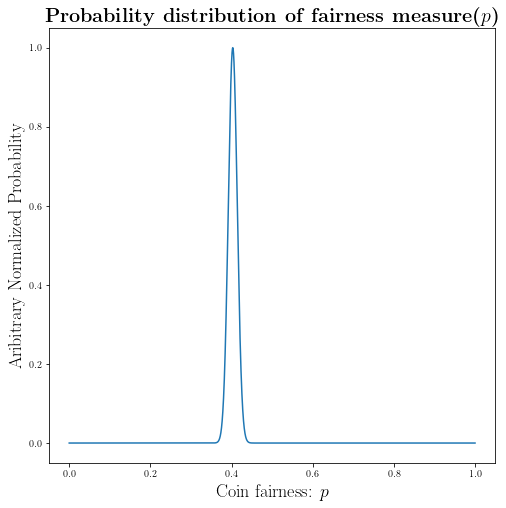
As you can see from our experiment we found the distribution of the interest: $P(p|X)$
Result:
The most likely value for the fairness of the coin is $0.403$, which shows that our coin is biased toward getting tail.
What is the numerical value of $\pi$?
There is a simple geometric approach we can use:
fig_pi = plt.figure(figsize=(8,8))
from matplotlib.patches import Rectangle
_number_of_points_=10**6
x = np.linspace(0,1, _number_of_points_)
y = np.sqrt(1-x**2)
# Plot the circle
plt.fill_between(x,y)
# There are more sophisticated ways to do this as well!
# Making the square
y1 = np.ones(10**6)
y2 = np.zeros(10**6)
# make the square plot
plt.plot(x, y1, "k")
plt.plot(x, y2, "k")
plt.plot(y2, x, "k")
plt.plot(y1, x, "k")
plt.title(r"\textbf{$\frac{\pi}{4}=S$, in which $S$: is the blue area}", fontsize=22)
plt.xlabel(r"x position", fontsize=18)
plt.ylabel(r"y position", fontsize=18)
plt.show()
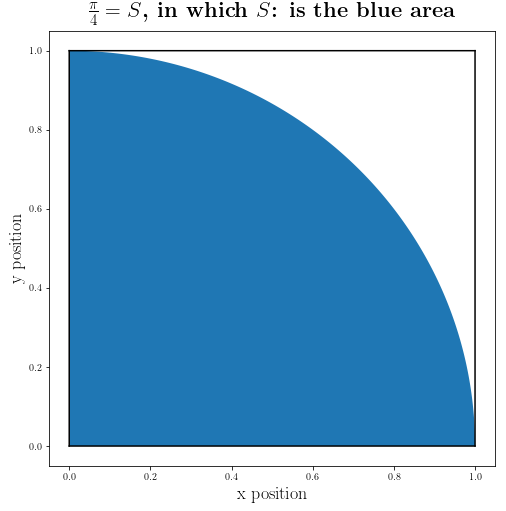
So if we somehow manage to find the blue area we can find the numerical value for $\pi$.
\(\begin{align*} & S = \frac{\pi R^2}{4} = \frac{\pi}{4} \quad \textrm{Since we know $R=1$} \\ & \pi = 4S \quad \textrm{So we need S} \end{align*}\)
How can we find the area numerically?
First we need to get familiar with the Monte Carlo Simulations
The Monte Carlo simulations, is a statistical technique to model stochastic (or probabilistic) systems and to find the probability of different outcome.
Further references: http://mathworld.wolfram.com/MonteCarloMethod.html
First let’s start with making $N$ random $(x,y)$ points from $[0,1]$ range:
N = 10e4
N = int(N)
x = np.random.random(N)
y = np.random.random(N)
Now we calculate the distance of each point from $(0,0)$: distance function –> d((x,y), (0,0))
distance_from_0_0 = np.sqrt(x**2 + y**2)
Let’s count number of points with $d((x,y), (0,0)) \leq 1$
circle_points = distance_from_0_0[distance_from_0_0<=1]
Now we have an array of distances for points inside the circle ($d((x,y), (0,0)) \leq 1$):
If we define $n$ to be the number of points within circle, and $N$ to be total number of points, We can find the area to be:
\[\begin{equation*} S = \frac{n}{N} \end{equation*}\]PI = 4 * len(circle_points)/len(distance_from_0_0)
print(PI)
3.14204
As you can see we are getting close to the True value.
Let’s put the above procedures inside a function:
def our_PI_generator(N=10e5):
"""This is our generic code for approximating pi ~ 3.14 with Monte Carlo simulation"""
import numpy as np
# initializing
N = int(N)
# Produce random numbers between [0,1] for (x,y)
x = np.random.random(N)
y = np.random.random(N)
# Find the distance of (x,y) from [0,0]
distance_from_0_0 = np.sqrt(x**2 + y**2)
# imposing the condition for the circle: distance((x,y),(0,0))<= 0
circle_points = distance_from_0_0[distance_from_0_0<=1]
return 4 * len(circle_points)/N
our_PI_generator(10e7)
3.1411142
Let’s use different number of points to see how adding to the number of points changes our numerical estimate for $\pi$:
np.logspace(2, 6, 10)
array([1.00000000e+02, 2.78255940e+02, 7.74263683e+02, 2.15443469e+03,
5.99484250e+03, 1.66810054e+04, 4.64158883e+04, 1.29154967e+05,
3.59381366e+05, 1.00000000e+06])
I = np.logspace(2, 6, 5000)
I = np.array([int(i) for i in I])
_x_ = [our_PI_generator(i) for i in I]
Here we assume the true value of $\pi$ is coming from numpy.pi. Let’s find the errors of our estimates:
distance_from_pi = np.array(_x_)-np.pi
This is how our estimate errors change with different number of points.
fig2 = plt.figure(figsize=(8,8))
plt.plot(np.log10(I), distance_from_pi)
plt.title(r"\textbf{Deviation from $\pi$ (\texttt{numpy.pi})}", fontsize=22)
plt.xlabel(r"$\log{N}$ in which $N: $ is number of points", fontsize=18)
plt.ylabel(r"$\pi_{mc}-\pi_{numpy}$", fontsize=18)
plt.show()

fig2 = plt.figure(figsize=(8,8))
plt.plot(np.log10(I), abs(distance_from_pi))
plt.title(r"\textbf{Absolute Deviation from $\pi$ (\texttt{numpy.pi})}", fontsize=22)
plt.xlabel(r"$\log{N}$ in which $N: $ is number of points", fontsize=18)
plt.ylabel(r"$\pi_{mc}-\pi_{numpy}$", fontsize=18)
plt.show()
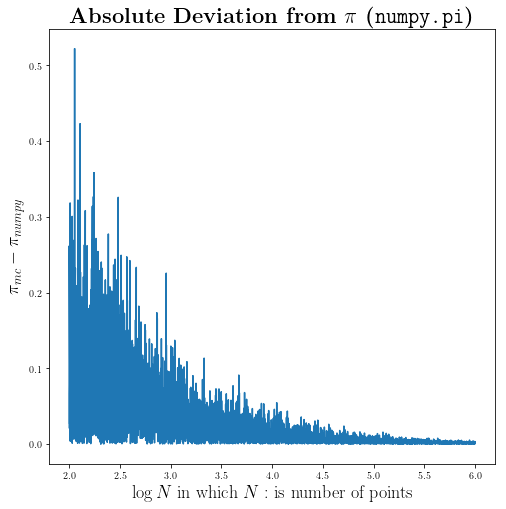
And as you would expect we are getting better and better by adding more points
Let’s put the selection criteria of the circle inside a function. (This can be generalize easily to any arbitrary geometric criteria)
def impose_circle(distances, radius=1):
"""
This is the function that takes an array `[distances]`
and a number (radius) and output an array of the similar
size, and for those value<radius, assigns 1 and the rest 0
"""
try:
lenght_of_array = len(distances)
except TypeError:
lenght_of_array = 1
selector=np.zeros(lenght_of_array)
for i in range(lenght_of_array):
if distances[i]<=radius:
selector[i] = 1
return selector
Now let’s divide our points into two dictionaries: inside_points and outside_points
selector = impose_circle(distance_from_0_0)
inside_points, outside_points = {}, {}
inside_points["x"] = x[selector==1]
inside_points["y"] = y[selector==1]
outside_points["x"] = x[selector==0]
outside_points["y"] = y[selector==0]
fig = plt.figure(figsize=(8,8))
plt.plot(inside_points["x"], inside_points["y"], '.', markersize=2,
label=r"$(x,y) | \sqrt{x^2+y^2} \leq 1 $")
plt.plot(outside_points["x"], outside_points["y"], '.', markersize=2, label=r"$(x,y) | \sqrt{x^2+y^2} > 1 $")
plt.title(r"\textbf{Monte Carlo simulation}", fontsize=22)
plt.xlabel(r"x position", fontsize=18)
plt.ylabel(r"y position", fontsize=18)
plt.legend(bbox_to_anchor=(1, 0.75), fontsize=18, markerscale=10)
plt.show()

This is how our Monte Carlo simulation actually look like!
Finding the area using Monte Carlo simulation:
fig_pi = plt.figure(figsize=(8,8))
from matplotlib.patches import Rectangle
_number_of_points_=10**6
x = np.linspace(0,1, _number_of_points_)
# defing our curves (circle R^2 = X^2 + Y^2)
y = np.sqrt(1-x**2)
_y_ = 1 - np.sqrt(1-(x-1)**2)
# Fill the area between two circles
plt.fill_between(x,y,_y_)
# Making the square
y1 = np.ones(10**6)
y2 = np.zeros(10**6)
# make the square plot
plt.plot(x, y1, "k")
plt.plot(x, y2, "k")
plt.plot(y2, x, "k")
plt.plot(y1, x, "k")
plt.title(r"\textbf{What is area of the blue section?}", fontsize=22)
plt.xlabel(r"x position", fontsize=18)
plt.ylabel(r"y position", fontsize=18)
plt.show()
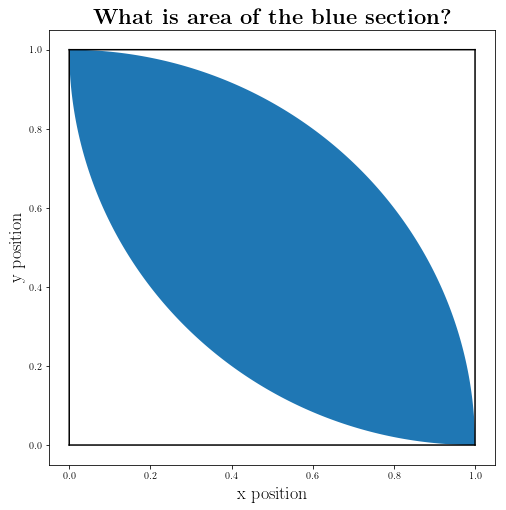
Let’s do some Monte Carlo simulation again:
N = 10e4
N = int(N)
# Points from (0,0)
x = np.random.random(N)
y = np.random.random(N)
dis=np.sqrt(x**2+y**2)
# Points frome (1,1)
x_1= np.ones(N)-x
y_1= np.ones(N)-y
dis1=np.sqrt(x_1**2+y_1**2)
Now that we have our points let’s apply the criteria:
selector=impose_circle(dis)
selector1=impose_circle(dis1)
final_sel = selector1*selector
_inside_points, _outside_points = {}, {}
_inside_points["x"] = x[final_sel==1]
_inside_points["y"] = y[final_sel==1]
_outside_points["x"] = x[final_sel==0]
_outside_points["y"] = y[final_sel==0]
fig = plt.figure(figsize=(8,8))
plt.plot(_inside_points["x"], _inside_points["y"], '.', markersize=2, label=r"$(x,y) | \sqrt{x^2+y^2} \leq 1$ and $\sqrt{(x-1)^2+(y-1)^2} \leq 1$")
plt.plot(_outside_points["x"], _outside_points["y"], '.', markersize=2, label=r"$(x,y) | \sqrt{x^2+y^2} > 1 $ or $\sqrt{(x-1)^2+(y-1)^2} > 1$")
plt.title(r"\textbf{Monte Carlo simulation}", fontsize=22)
plt.xlabel(r"x position", fontsize=18)
plt.ylabel(r"y position", fontsize=18)
plt.legend(loc='upper center', bbox_to_anchor=(1.5, 0.75), fontsize=18, markerscale=10)
plt.show()

area_of_middle = len(_inside_points["x"])/len(x)
area_of_middle
0.5708
Finding the Area geometrically:
Let’s find the area for the part of square that we took fourth of a circle ($A_{extra}$) from and take two of them from the area of a square.
$A_{extra} = A_{square}-\frac{A_{circle}}{4}$
The area that we are looking for becomes:
$A_{shape} = A_{square} - 2 A_{extra}$
Let’s plug in known quantities: $A_{shape} = R^2 - 2(R^2 - \frac{\pi R^2}{4})$
\[\begin{equation*} A_{shape} = R^2 (\frac{\pi}{2}-1) \end{equation*}\]for special case of $R=1$ it becomes:
\[\begin{equation*} A_{shape} =\frac{\pi}{2}-1 \end{equation*}\]Coding directly to find the area: (above calculation is inside the code)
area_curve = 1 - np.pi/4
two_curved_area = 2*area_curve
area_of_middle_geometry = 1 - two_curved_area
area_of_middle_geometry
0.5707963267948966
Using the formula directly:
np.pi/2-1
0.5707963267948966
And as you would expect all of these methods are giving us consistent results.
Random Walk: As a simple example of modeling a random process
We are going to make a random walk and try to answer basic questions like what is the expected distance from the staring point, path, …
There are few ways of approaching this problem:
- Functional approach: Building the whole process as a pipeline of different functions, which is the approach we used so far.
- Object oriented approach: Which is conceptually a very different approach but by doing this exercise we’ll learn why this approach can be very useful for some problems.
Tip: Deciding what approach to take for a particular problem, depends on many factors. One of the easiest factor which is mainly independent of the problem is that whether you are going to reuse your codes again or adding different features to it later. If that’s the case, generally speaking it is better to try to think about the problem and implement your code with the object oriented approach.
Like always let’s start with the simplest case: 1-d random walk
def random_walk_1d(n, step=1):
"""This is a function for making a 1-d random walk
INPUT:
n (int): number of steps to take
step (float): length of each steps
OUTPUT:
positions (numpy.array): an array of different positions during
the random walk
"""
import random
import numpy as np
# making an array for putting all the information
positions=np.zeros(n)
# initial position
x = positions[0]
for i in range(1,n):
# choosing the random step to take
dx = random.choice([1,-1])*step
x+=dx
positions[i]=x
return positions
Let’s use our code above for finding a min(max) of a given function:
def f(x):
return x**2+2*x
We can find the minimum:
$\frac{df(x)}{dx}=2x+2$
Which has the solution of $x=-1$
def min_finder(_f, xi=0, step=0.01, n=100):
import random
import numpy as np
positions=np.zeros(n)
x = xi
for i in range(1,n):
stay = 1
while stay==1:
dx = random.choice([1,-1])*step
x_dummy=x+dx
if _f(x_dummy)<=_f(x):
positions[i]=x_dummy
x = x_dummy
stay = 0
return positions
We got the same results with our greedy random walk algorithm:
min_finder(f, n=100)[-1]
-0.9900000000000007
Now let’s go to 2-d random walk:
def random_walk_2d(n):
"""2-d random walk function
INPUT:
n (int): number of steps to take
OUTPUT:
positions_dic (dic): A dictionary which contains am array of x and y values and
the keys are "x" and "y"
"""
x,y = 0, 0
import random
positions_dic={}
positions_dic["x"]=np.zeros(n)
positions_dic["y"]=np.zeros(n)
for i in range(1, n):
(dx, dy) = random.choice([(0,1), (0,-1), (1,0), (-1,0)])
x,y=x+dx,y+dy
positions_dic["x"][i]=x
positions_dic["y"][i]=y
return positions_dic
N = 10000
positions_walker_0=random_walk_2d(N)
positions_walker_1=random_walk_2d(N)
fig_2d_rw = plt.figure(figsize=(8,8))
plt.plot(positions_walker_0["x"], positions_walker_0["y"], label="Walker 0")
plt.plot(positions_walker_1["x"], positions_walker_1["y"], label="Walker 1")
plt.title(r"\textbf{Random walk in 2-dimension}", fontsize=22)
plt.xlabel(r"x position", fontsize=18)
plt.ylabel(r"y position", fontsize=18)
plt.legend(fontsize=18, markerscale=10)
plt.show()
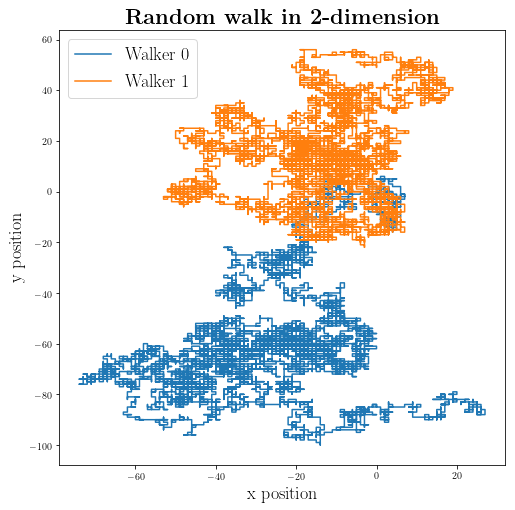
Now that we have our random walk function we can run a simulation of $N$ step random walk and record the distances from origin:
Number_of_simulations = 2000
distance=np.zeros(Number_of_simulations)
Number_of_walks_in_each_simulation = 10000
for i in range(Number_of_simulations):
positions=random_walk_2d(Number_of_walks_in_each_simulation)
distance[i]=np.sqrt(positions["x"][-1]**2+positions["y"][-1]**2)
hist_rw = plt.figure(figsize=(8,8))
plt.hist(distance)
plt.title(r"\textbf{Random walk in 2-dimension}", fontsize=22)
plt.xlabel(r"Distances from origin", fontsize=18)
plt.ylabel(r"Number counts", fontsize=18)
plt.show()

np.sqrt(Number_of_walks_in_each_simulation)
100.0
The $\sqrt{N}$ in which $N$ is number of steps is very close to the most likely value. Something to check and think about later.
Here we are writing a function to simulate $N$ simulations with $n$ steps:
def Simulate_walks(number_of_steps, number_of_simulations):
simulation={}
for i in range(number_of_simulations):
simulation[i]=random_walk_2d(number_of_steps)
return simulation
Now let’s make a random walker which can move along different angles.
def random_walk_2d_degree_free(n):
x,y = 0, 0
degree=0
import random
import numpy as np
positions_dic={}
positions_dic["x"]=np.zeros(n)
positions_dic["y"]=np.zeros(n)
for i in range(1, n):
# Choose a degree in radian between [0, 2*pi] with 100000 choices for angles
degree = random.choice(np.linspace(0, 2*np.pi, 100000))
(dx, dy) = (np.cos(degree), np.sin(degree))
x,y=x+dx,y+dy
positions_dic["x"][i]=x
positions_dic["y"][i]=y
return positions_dic
positions_walker_deg_0 = random_walk_2d_degree_free(1000)
positions_walker_deg_1 = random_walk_2d_degree_free(1000)
fig_2d__deg_rw = plt.figure(figsize=(8,8))
plt.plot(positions_walker_deg_0["x"], positions_walker_deg_0["y"], label="Walker 0")
plt.plot(positions_walker_deg_1["x"], positions_walker_deg_1["y"], label="Walker 1")
plt.title(r"\textbf{Random walk in 2-dimension}", fontsize=22)
plt.xlabel(r"x position", fontsize=18)
plt.ylabel(r"y position", fontsize=18)
plt.legend(fontsize=18, markerscale=10)
plt.show()

Let’s implement the random walk in a object-oriented framework:
First we need to define few classes:
First one is the position class which act as our position tracker and have few methods: move, findX, findY, and distance
class position(object):
def __init__(self, x, y):
"""x,y are float type"""
# assigning the initial position
self.x = x
self.y = y
def move(self,dx,dy):
"""dx,dy are float type: function to make a new position object at the new coordinates moved by (dx, dy)"""
return position(self.x+dx, self.y+dy)
def findX(self):
"""Give the x coordinate of the object"""
return self.x
def findY(self):
"""Give the y coordinate of the object"""
return self.y
def distance(self, other):
"""other is an object from position class: function will calculate their relative distance between self, and other"""
delta_x = self.x - other.findX()
delta_y = self.y - other.findY()
return (delta_x**2+delta_y**2)**0.5
def __str__(self):
return "({},{})".format(self.x, self.y)
Here I just defined two points $(a,b)$ and I will use the distance method:
a = position(1,2)
b = position(4,5)
b.distance(a)
4.242640687119285
a.distance(b)
4.242640687119285
Great! It seems to work fine!
This is the base class and it’s not something useful by itself and it will be inherited.
# we are going to pass this class to another classes below
class walker(object):
def __init__(self, name= None):
"""assume name is a string"""
self.name = name
def __str__(self):
if self.name != None:
return self.name
return "Unkown"
Here we are going to make two types of walker:
- Normal walker: which has no preference for any directions.
- Biased walker: which has some bias toward a particular direction. (in our case in y direction)
import random
class Normal_walker(walker):
def take_step(self):
"""Taking a random choice out of all the possible moves"""
choices_of_steps = [(0,1), (1,0), (0,-1), (-1,0)]
return random.choices(choices_of_steps)[0]
class Biased_walker(walker):
"""Taking a random choice out of all the possible moves"""
def take_step(self):
choices_of_steps = [(0,1.5), (1,0), (0,-0.5), (-1,0)]
return random.choices(choices_of_steps)[0]
Notice that we have the same name for take_step methods under different sub-classes of walker which is different when the class is different.
Now we need to define a class for the space that we need to put the walkers in:
class Space(object):
def __init__(self):
self.walkers={}
def addWalker(self, walker, pos):
"""Takes a walker and position class and will add it to our dictionary of walkers, if the walker does not already exist"""
if walker in self.walkers:
raise ValueError("Walker already exist")
else:
self.walkers[walker]=pos
def getPos(self, walker):
"""Will take a walker class and give back the position class assigned to it"""
if walker not in self.walkers:
raise ValueError("No such Walker exist in our space!")
return self.walkers[walker]
def moveWalker(self, walker):
"""Take a walker class and dependent on what subclass was chosen in defining the walker, takes step"""
if walker not in self.walkers:
raise ValueError("No such Walker exist in our space!")
Delta_x, Delta_y = walker.take_step()
# moving the walker to new position (class)
self.walkers[walker] = self.walkers[walker].move(Delta_x, Delta_y)
Now that we built up our position, walker, and Space we can make a random walk:
def walk(space, walker, number_of_steps, log_pos=False):
""" function for performing a random walk for a given walker
INPUT:
-------
space is from Space cls
walker is from Walker cls
number_of_steps is integer>=0
OUTPUT:
-------
IF log_pos == False:
Function will produce the distance between starting
position of the walker and the last location.
IF log_pass == True:
Function will produce a list of all the positions
walker was during the walk.
"""
# Find the initial postion of the walker in the space
starting_position = space.getPos(walker)
# Move the walker in the space
save_all_pos = []
for i in range(number_of_steps):
pos_=space.getPos(walker)
if log_pos:
save_all_pos.append((pos_.findX(), pos_.findY()))
space.moveWalker(walker)
if log_pos:
return save_all_pos
return starting_position.distance(space.getPos(walker))
In the following we are going to define a function to perform severel random walks:
def simulate_walks(number_of_steps, number_of_simulations, walker_class_type, origin=position(0,0)):
"""
This is function that runs simulation for given variables:
INPUT:
number_of_steps: How many step the walker should take
number_of_simulations: How many simulation to run
walker_class_type: The type of walker class (a subclass of walker)
origin: Should be an instance of the class position
Output:
A list of distances from origins
"""
our_walker = walker_class_type("walker_1")
distances=[]
for i in range(number_of_simulations):
space = Space()
space.addWalker(our_walker, origin)
distances.append(walk(space, our_walker, number_of_steps))
return distances
def test_simulation(walk_lenght_array, number_of_simulations, walker_class_type):
"""
Some sanity checks on the simulations
"""
for walk_length in walk_length_array:
_distances_ = simulate_walks(walk_length, number_of_simulations, walker_class_type)
print(walker_class_type.__name__, " random walk of {} steps".format(walk_length), " After {} simulations".format(number_of_simulations))
print(" Mean= {}".format(round(sum(_distances_)/len(_distances_),4)))
print(" Max= {}".format(round(max(_distances_), 4)))
print(" Min= {}".format(round(min(_distances_),4)))
test_simulation([0,1,2, 10**3, 10**5], 100, Normal_walker)
Normal_walker random walk of 0 steps After 100 simulations
Mean= 0.0
Max= 0.0
Min= 0.0
Normal_walker random walk of 1 steps After 100 simulations
Mean= 1.0
Max= 1.0
Min= 1.0
Normal_walker random walk of 2 steps After 100 simulations
Mean= 1.3285
Max= 2.0
Min= 0.0
Normal_walker random walk of 1000 steps After 100 simulations
Mean= 28.7257
Max= 91.7061
Min= 2.8284
Normal_walker random walk of 100000 steps After 100 simulations
Mean= 286.1797
Max= 830.3794
Min= 30.2655
test_simulation([0,1,2, 10**3, 10**5], 100, Biased_walker)
Biased_walker random walk of 0 steps After 100 simulations
Mean= 0.0
Max= 0.0
Min= 0.0
Biased_walker random walk of 1 steps After 100 simulations
Mean= 0.965
Max= 1.5
Min= 0.5
Biased_walker random walk of 2 steps After 100 simulations
Mean= 1.3026
Max= 3.0
Min= 0.0
Biased_walker random walk of 1000 steps After 100 simulations
Mean= 250.9924
Max= 303.2375
Min= 196.4688
Biased_walker random walk of 100000 steps After 100 simulations
Mean= 25029.4813
Max= 25708.3555
Min= 24292.8114
The next function is going to run the simulation for both walker types, Notice that is general for any number of walker types, here we only defined two but can be extended as well.
def test_simulate_all_walker_types(walk_lenght_array, number_of_simulations, walker_types):
for walker in walker_types:
test_simulation(walk_lenght_array, number_of_simulations, walker)
test_simulate_all_walker_types([0,1,2], 100, [Biased_walker, Normal_walker])
Biased_walker random walk of 0 steps After 100 simulations
Mean= 0.0
Max= 0.0
Min= 0.0
Biased_walker random walk of 1 steps After 100 simulations
Mean= 1.07
Max= 1.5
Min= 0.5
Biased_walker random walk of 2 steps After 100 simulations
Mean= 1.2585
Max= 3.0
Min= 0.0
Normal_walker random walk of 0 steps After 100 simulations
Mean= 0.0
Max= 0.0
Min= 0.0
Normal_walker random walk of 1 steps After 100 simulations
Mean= 1.0
Max= 1.0
Min= 1.0
Normal_walker random walk of 2 steps After 100 simulations
Mean= 1.1681
Max= 2.0
Min= 0.0
Here we are running the simulation at will find the average of different simulations for the given (fixed) number of steps. We are going to that for the range of steps
from time import time
number_of_simulations=100
number_of_steps_range=300
ti= time()
distances= [np.mean(simulate_walks(n,number_of_simulations, Normal_walker)) for n in range(number_of_steps_range)]
print("Runtime for Normal walker: {} s".format(time()-ti))
ti= time()
distances_biased = [np.mean(simulate_walks(n,number_of_simulations, Biased_walker)) for n in range(number_of_steps_range)]
print("Runtime for Biased walker: {} s".format(time()-ti))
Runtime for Normal walker: 9.139477729797363 s
Runtime for Biased walker: 9.050119876861572 s
fig = plt.figure(figsize=(8,8))
slope=0.25
plt.plot(range(number_of_steps_range), distances_biased, label="Biased walker (0.5)")
plt.plot(range(number_of_steps_range), distances, label="Normal walker")
plt.plot(range(number_of_steps_range), np.sqrt(range(number_of_steps_range)), label="$y=\sqrt{x}$")
plt.plot(range(number_of_steps_range), slope*np.array(range(number_of_steps_range)), label="$y={} x$".format(slope))
plt.xlabel(r"Number of Steps", size=16)numpynumpy
plt.ylabel(r"Average Distance from origin", size=16)
plt.legend(fontsize=18)
plt.show()
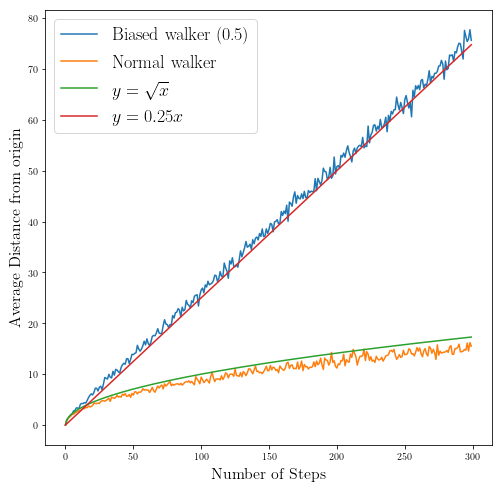
Which as you can see, when you add a bias to your random walk is going to make the average distance to scale with Number of steps instead of square root of the number of steps which is the case for normal walker.
Monte Carlo simulation for roulette game:
Here is a picture of a roulette game: (for more info check out the wikipedia)
In this excersie we are going to run some Monte Carlo simulations for the roulette game to see what is our average take out from the game. We are going to explore three different versions:
- Fair Roulette
- European Roulette
- American Roulette
left: American Roulette
right:European Roulette


First we are going to build a game class that initialize the staring configuration as well having some methods we need such as spin and bet_pocket:
import random
class Fair_roulette:
def __init__(self):
self.pockets = []
for i in range(1,37):
self.pockets.append(i)
self.ball = None
self.pocket_odds = len(self.pockets) - 1
def spin(self):
self.ball = random.choice(self.pockets)
def bet_pocket(self, pocket, money_amount):
if str(pocket) == str(self.ball):
return money_amount*self.pocket_odds
else:
return -money_amount
def __str__(self):
return "Fair Roulette"
This is the function that will play the roulette for us:
def play_roulette(game, number_of_spins, pocket, amount_bet):
total_pocket = 0
for i in range(number_of_spins):
game.spin()
total_pocket += game.bet_pocket(pocket, amount_bet)
ratio=total_pocket/number_of_spins
print(number_of_spins, " spins of the ", game)
print("Expected return for ", pocket, "is ", str(100*ratio)+"% \n")
return (ratio)
Let’s do some simulation for the fair roulette:
our_game = Fair_roulette()
which_pocket_to_bet = 7
bet_amount = 1
list_of_spins = [10, 100, 1000, 10000, 100000, 10**6]
for spins_num in list_of_spins:
for _ in range(2):
play_roulette(our_game, spins_num, which_pocket_to_bet, bet_amount)
10 spins of the Fair Roulette
Expected return for 7 is 620.0%
10 spins of the Fair Roulette
Expected return for 7 is 260.0%
100 spins of the Fair Roulette
Expected return for 7 is -64.0%
100 spins of the Fair Roulette
Expected return for 7 is -28.000000000000004%
1000 spins of the Fair Roulette
Expected return for 7 is -2.8000000000000003%
1000 spins of the Fair Roulette
Expected return for 7 is 8.0%
10000 spins of the Fair Roulette
Expected return for 7 is -10.72%
10000 spins of the Fair Roulette
Expected return for 7 is 1.52%
100000 spins of the Fair Roulette
Expected return for 7 is 2.42%
100000 spins of the Fair Roulette
Expected return for 7 is 0.5479999999999999%
1000000 spins of the Fair Roulette
Expected return for 7 is 0.5228%
1000000 spins of the Fair Roulette
Expected return for 7 is 1.3004%
As you can see the variations for the money we take is huge when the number of spins are low, but when we get to $n>10^5$ simulations our results is fairly close to zero which it is a god news since it means our game is fair.
For making the European version of the game which has an extra 0 in it, we are going to make some sub-class of the fair roulette class. And the american game has another extra number 00 on top of the European version so we make it as a sub-class of the European game.
class European_roulette(Fair_roulette):
def __init__(self):
Fair_roulette.__init__(self)
self.pockets.append("0")
def __str__(self):
return "European Roulette"
class American_roulette(European_roulette):
def __init__(self):
European_roulette.__init__(self)
self.pockets.append("00")
def __str__(self):
return "American Roulette"
As you probably guessed we are adding to the number of possible places for the ball without changing the odds of the winning. We have 37-38 possible place for the ball but when we win we are going to win 36 dollars per each dollar.
Let’s run our simulations again and see what is going to change to our average takeouts:
our_games = (Fair_roulette(), European_roulette(), American_roulette())
which_pocket_to_bet = 2
bet_amount = 1
list_of_spins = [10, 100, 10**6]
for game in our_games:
for spins_num in list_of_spins:
for _ in range(2):
play_roulette(game, spins_num, which_pocket_to_bet, bet_amount)
10 spins of the Fair Roulette
Expected return for 2 is -100.0%
10 spins of the Fair Roulette
Expected return for 2 is -100.0%
100 spins of the Fair Roulette
Expected return for 2 is -28.000000000000004%
100 spins of the Fair Roulette
Expected return for 2 is 8.0%
1000000 spins of the Fair Roulette
Expected return for 2 is -0.3664%
1000000 spins of the Fair Roulette
Expected return for 2 is -0.6904%
10 spins of the European Roulette
Expected return for 2 is -100.0%
10 spins of the European Roulette
Expected return for 2 is -100.0%
100 spins of the European Roulette
Expected return for 2 is 8.0%
100 spins of the European Roulette
Expected return for 2 is -28.000000000000004%
1000000 spins of the European Roulette
Expected return for 2 is -2.4903999999999997%
1000000 spins of the European Roulette
Expected return for 2 is -2.7567999999999997%
10 spins of the American Roulette
Expected return for 2 is -100.0%
10 spins of the American Roulette
Expected return for 2 is -100.0%
100 spins of the American Roulette
Expected return for 2 is -64.0%
100 spins of the American Roulette
Expected return for 2 is 115.99999999999999%
1000000 spins of the American Roulette
Expected return for 2 is -4.4704%
1000000 spins of the American Roulette
Expected return for 2 is -4.5856%
As you can see for small number of spins we still have a huge variations between different runs for all versions of the game. But the story is different for the large numbers! In the European version you are losing by about 2-3 percent and in the American version you are losing 4-5 percent on average.
So now you know how casino can make money out of this game, since they are not interested in average of the money they win/lose in small number of spins, instead they are making money on the long run.
The other interesting thing about the experiment is that if you decide to gamble with roulette for only few spins you can get lucky few times since the variation of the expected value is large, but don’t plan to make money in this way since you are going to lose to casino in the long run!
Go to Week 4 »
« Go to Week 2
References:
https://en.wikipedia.org/wiki/Monte_Carlo_method
https://www.mit.edu/~kardar/teaching/projects/chemotaxis(AndreaSchmidt)/random.htm
http://physics.gu.se/~frtbm/joomla/media/mydocs/LennartSjogren/kap2.pdf
